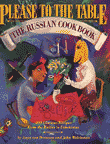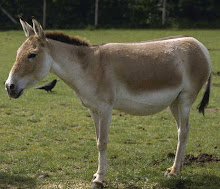 Several weeks ago, archaeologists published findings of what is believed to be a prehistoric corral, at the Botai settlement of Krasny Yar in Northern Kazakhstan (articles at LiveScience.com and Scientific American.com). Since the only animals in the southern steppe that might have needed a corral would be horses, this discovery is seen as further evidence that the Botai people domesticated and possibly even learned to ride horses as early as 3500 BC.
Several weeks ago, archaeologists published findings of what is believed to be a prehistoric corral, at the Botai settlement of Krasny Yar in Northern Kazakhstan (articles at LiveScience.com and Scientific American.com). Since the only animals in the southern steppe that might have needed a corral would be horses, this discovery is seen as further evidence that the Botai people domesticated and possibly even learned to ride horses as early as 3500 BC.Though research shows the Botai to have been a completely new kind of civilization from previous steppe peoples, interest and research has been concentrated on their relationship to the wild horses of the steppe, and on what light their civilization can shed on the history of equine domestication. Archeological sites in Ukraine have some evidence of earlier horse domestication (breeding them in captivity as opposed to taming wild horses), ca.5,000 BC, so the question of “who rode first” is a hotly debated topic in contemporary archeology.
The domestication of the horse was a watershed moment in human history -- with a year-round source of meat and milk (as cattle have been in the West), nutrition and migratory patterns of the nomads would have been drastically affected. Once horses were used as tools, for carrying loads, and for travelling long distances when migrating and hunting, the possibilities for human development increased dramatically. Until recently, the Botai have been considered to be Caucasoid/European, but other researchers have used computer modeling to reconstruct a Botai skull, the results of which resemble a modern Kazakh male (the image actually looks a lot like a young Kazakh grad student I know).
With synchronicity factor in full gear, I soon stumbled across a recently published young adult novel called Wind Rider. The author, Susan Williams, has written a richly-imagined tale of the first person, a teenage girl, ever to tame and ride a wild horse in the Central Asian steppe. Young Fern, daughter of a family of hunting and gathering Earth People, finds more comfort in her animal friends than with humans, and is not looking forward to the limited life destined for her as a woman. The five families of her clan travel together during the warm months, and live with other clans in a protected settlement of pit houses during the storms of winter.
One spring, Fern saves the life of an orphaned filly, which she names Thunder. Secretly keeping Thunder in a makeshift corral to protect her from being killed for food, Fern tames the filly and learns to use the young horse’s strength to assist her and her people. In dreams, she has seen herself flying on the back of a horse, and eventually Fern learns to ride Thunder, inventing a leather bridle, bone bits, felt blankets and other riding tools.
This imagined scenario is entirely plausible, and the details are well-researched (as described in the author’s note at the end). For example, the Earth People (Botai?) respect and pay tribute to the life spirits inherent in all things, a possible precursor to the animistic beliefs of pre-Islamic Kazakh nomads. They fear the Night People, a harsh, cruel tribe who worship the god White Horse as master and creator. Night People keep a captured white stallion as the incarnation of White Horse, and to this horse they give ritual sacrifices; there is archaeological and anthropological evidence of horse-worship among the pre-Botai cultures on the steppe.
The novel is well crafted, though the basic story isn’t wildly original. For readers looking for a strong female coming-of-age tale, for all horse-lovers, and anyone interested in Kazakh prehistory, this is a solid recommended read.
For middle graders & up.
More About the Book
• Author Interview with Susan Williams
• Author's Website
• Chapter One Excerpt
More About the Botai Culture
• Prehstory of Kazakhstan at the Carnegie Mellon Museum
• Botai Discovery page (in progress)


No comments:
Post a Comment